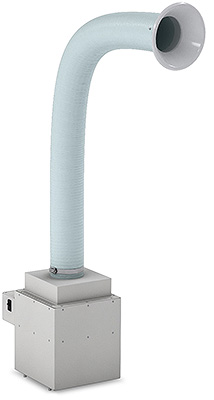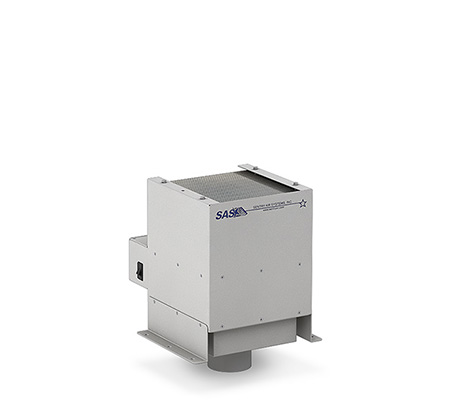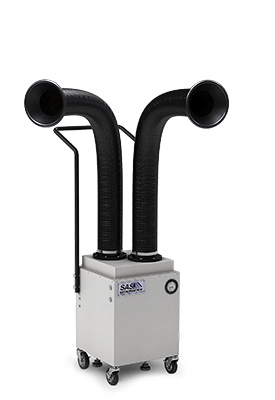Laser Fume Extractors
Laser fume extractors capture hazardous fumes and particulate at the source before entering the operator’s breathing zone or soiling the laser system. Fume extraction systems are available in different configurations including exhaust port connection, multiple exhaust port connection, and standalone source capture. Exhaust port connection models mount directly to the laser system with a flame-retardant flexible hose. Multiple exhaust port connection units connect to multiple exhaust ports on one unit, or one port on two or four nearby systems. Standalone source capture fume extractors don’t directly mount but stand next to the unit to extract fumes with a flexible arm. These laser fume extractors provide fume and particulate control for laser systems used in industrial, commercial, medical, and laboratory applications.

Portable Floor Sentry
The Portable Floor Sentry fume extractor is a safety engineering control used for the capture and filtration of airborne contaminants. This source-capture fume extractor features heavy-duty casters for easy mobility, a flame-retardant and self-supportive flex arm, a small footprint, and high-quality filtration media.
Several filter media options are available for this unit and include: HEPA filtration [up to 99.97% efficient on particles 0.3 microns and larger, ASHRAE filtration [up to 95% efficient on particles 0.5 microns and larger], Activated Carbon, and specialty-blended filter media [i.e. Acid Gas, Mercury, Aldehyde, Ammonia]. The Portable Floor Sentry Fume Extractor allows multiple filter media to be housed inside the filter chamber for applications that emit both particulates and fumes.

Mounted
The mounted fume extractor is an incomparably manufactured air filtration system that is specifically built for work areas with minimal space allotted. Available to be mounted to shelves, tables, enclosures, machines, and other locations that require direct mouing, these units feature small footprints, allowing them to be easily integrated to work with existing equipment and workspace arrangements.

Multi-Operator
Multi-Operator fume extractors are uniquely designed to provide fume extraction for two or more operators simultaneously. These air filtration systems utilize multiple self-supportive flex arms with full range (360° rotation) capability to provide equal suction at all inlets, thereby protecting the immediate breathing zones of each operator.
Several filter media options are available for this unit and include: HEPA filtration [up to 99.97% efficient on particles 0.3 microns and larger, ASHRAE filtration [up to 95% efficient on particles 0.5 microns and larger], Activated Carbon, and specialty-blended filter media [i.e. Acid Gas, Mercury, Aldehyde, Ammonia]. The Portable Floor Sentry Fume Extractor allows multiple filter media to be housed inside the filter chamber for applications that emit both particulates and fumes.
What Are Laser Fumes?
Laser fumes are produced when a high energy laser beam comes into contact with a substrate such as metal or plastic. The heat from the laser beam provokes the material to release smoke or a plume of laser fumes. The high temperature expands the surrounding air creating airborne microscopic particles. These microscopic particles can become lodged deep within the lungs causing long-lasting health effects.
The main types of laser systems include CO2, fiber, and Nd/Nd-Yag (or crystal). CO2 laser systems create the laser electrically fueled with CO2 and widely used for laser cutting and laser marking due to the ability to manipulate a wide variety of substrates such as metal, wood, plastic, acrylic, and many more. Fiber lasers systems have a seed laser amplified by glass fibers and work best for etching metals, coated metals, and plastics. Lastly, Nd/Nd-Yang or crystal laser systems use pumped diodes to mark metals, plastics, and sometimes ceramics.
Laser Fume Extraction
Laser Fume Hazards
The particulate and fume by-products of laser engraving and laser cutting operations can be hazardous to both the operator and the laser system itself. Conditions vary depending on the material being marked or cut, but many of these processes can produce respiratory hazards that may lead to acute or long-term negative health effects. According to the Princeton University Environmental Health and Safety website, examples of air contaminants produced by the interaction between the laser beam and target matter might include the following:
|
Harmful Contaminant |
Activity & Base Material |
Polycyclic Aromatic Hydrocarbons |
Mode Burns on Poly (Methyl Methacrylate) Type Polymers |
| Hydrogen Cyanide and Benzene | Cutting of Aromatic Polyamide Fibers |
| Fused Silica | Cutting Quartz |
| Heavy Metals | Etching |
| Benzene | Cutting Polyvinyl Chloride |
| Cyanide, Formaldehyde and Synthetic and Natural Fibers | Other Processes |
Laser Fume Health Hazards
Health effects vary depending on the chemicals involved and range from acute health effects (ie. irritation of the nose, eyes, and throat) to long-term (ie. asthma or nervous systems damage).
Laser Fume Regulations
In OSHA’s Technical Manual Regarding Laser Fumes:
INDUSTRIAL HYGIENE. Potential hazards associated with compressed gases, cryogenic materials, toxic and carcinogenic materials, and noise should be considered. Adequate ventilation shall be installed to reduce noxious or potentially hazardous fumes and vapors, produced by laser welding, cutting and other target interactions, to levels below the appropriate threshold limit values, e.g., American Conference of Governmental Industrial Hygienists (ACGIH) threshold limit values (TLV’s) or Occupational Safety and Health Administration’s (OSHA) permissible exposure limits (PEL’s).

 Made in the USA
Made in the USA